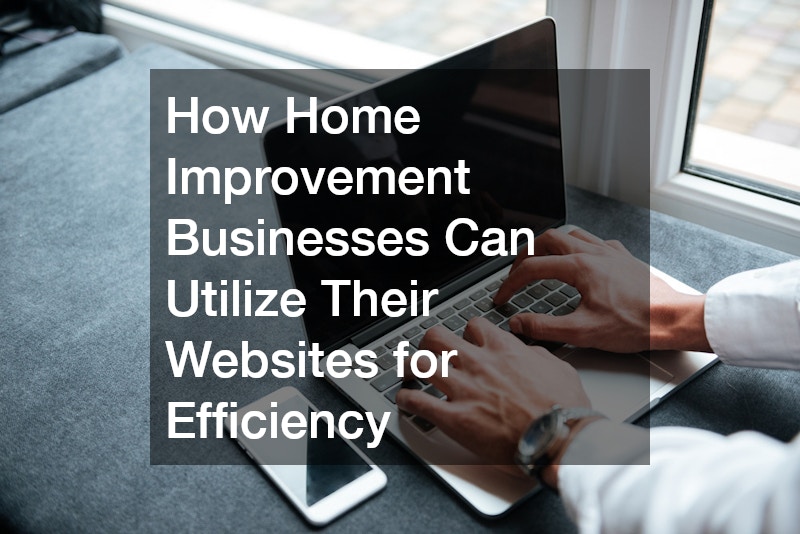
In today’s digital age, having a well-optimized website for home improvement businesses is no longer just a luxury; it’s a necessity. Homeowners and property managers are increasingly turning to the internet to find service providers, from plumbers to demolition contractors. This trend emphasizes the importance of a strong online presence and effective website functionalities, which can not only attract customers but also streamline operations.
For businesses focused on services like mold removal or bathtub repairs, a robust online platform can help showcase expertise and services available. Furthermore, features that enhance user experience can significantly improve customer engagement, leading to lasting relationships. Whether an enterprise is selling new garage doors or offering cabinet and vanity installations, having an informative, user-friendly website is essential.
As the home improvement sector becomes increasingly competitive, leveraging technology through websites can give businesses the edge they need. Integrating various digital tools can enhance efficiency, provide insights, and ultimately lead to increased revenue. This article delves into how home improvement businesses can harness their websites for greater efficiency and success.
1. How Can a Website Improve Customer Engagement?
Customer engagement is critical for any service-based business, especially in the home improvement sector. A well-designed website offers potential clients valuable information, helping them make informed decisions. Features like user-friendly navigation, engaging content, and easy-to-find contact details can keep visitors on the site longer, boosting the chances of conversion.
By providing resources such as guides on calcium hardness for pools or tips for hiring concrete cutting contractors, businesses can position themselves as industry leaders. Blog posts and videos on topics like mold removal or bathtub repairs serve as excellent tools for engaging audiences. Additionally, including call-to-action buttons can encourage users to book services directly, further fostering interaction.
Moreover, implementing live chat functionalities can significantly enhance customer service. Immediate assistance can alleviate concerns and help potential customers feel valued. Such interactive features contribute not only to improved client relations but also to higher rates of conversion.

2. What Features Should Be Included for Mobile Optimization?
With a growing number of users browsing on mobile devices, optimizing websites for mobile viewing is imperative. This ensures that information regarding services such as new garage doors or cabinets and vanities is easily accessible, regardless of the device. Ensuring that the website is responsive means that images and text will adjust seamlessly to fit any screen size.
Mobile optimization should also include fast loading times and simplified navigation. A website that takes too long to load or has a complicated design can lead to high bounce rates. Implementing mobile-friendly features, such as tap-to-call buttons, makes it convenient for users to reach out directly to services like plumbing or demolition contractors.
Additionally, tailored content for mobile users can enhance their experience. For instance, presenting quick tips on security fence installations or summarized information about services offered fosters easier understanding. Ultimately, a mobile-optimized site can significantly improve user satisfaction and engagement.
3. How Can SEO Help Home Improvement Businesses?
Search Engine Optimization (SEO) is crucial in improving the visibility of home improvement websites. By strategically using keywords such as “mold removal,” “bathtub repairs,” and “calcium hardness for pool,” businesses can rank higher in search engine results. This visibility can lead to increased organic traffic, attracting potential customers searching for specific services.
Moreover, local SEO techniques can significantly benefit home improvement businesses. Many customers look for nearby services, so optimizing for local searches can enhance visibility within target markets. Keywords associated with specific service areas or neighborhoods can drive location-based traffic effectively, making it easier for homeowners to find needed services, whether it’s a plumber or concrete cutting contractors.
Regularly creating fresh, relevant content is another component of successful SEO. Publishing blog articles, tips, and project showcases establishes authority and draws more visitors to the site. Over time, this not only enhances search rankings but also builds trust with potential customers.
4. What Are the Benefits of Online Reviews and Testimonials?
Online reviews and testimonials play a pivotal role in influencing potential customers. Home improvement businesses can leverage these endorsements to build credibility and trust in services such as mold removal or installation of cabinets and vanities. Positive feedback can often serve as a deciding factor for prospective clients when comparing service providers.
Displaying reviews prominently on a website can enhance user confidence. A section dedicated to testimonials can showcase real experiences, helping new visitors understand the quality of services offered. Furthermore, responding to reviews, both positive and negative, demonstrates a commitment to customer satisfaction, encouraging even more engagement.
Using customer feedback effectively can also provide insights for improving services. Analyzing reviews can highlight areas where businesses excel or need enhancement, guiding future decisions. Ultimately, the incorporation of reviews can significantly enhance an enterprise’s image and attract more clientele.

5. How Can Integrating E-commerce Enhance Sales?
Integrating e-commerce capabilities into a home improvement website can significantly enhance sales opportunities. For example, businesses can offer products like new garage doors or security fences directly through their website. This allows customers to browse, compare, and purchase products from the comfort of their homes, expanding sales beyond traditional in-person transactions.
Moreover, e-commerce allows for the offering of bundled services or seasonal promotions that can provide additional value to clients. Packages that combine installation services with product purchases encourage higher spending. Showcasing these deals on the website can attract customers looking for convenience and comprehensive solutions.
Additionally, an efficient checkout process is essential for a successful e-commerce strategy. Integrating various payment options and ensuring a secure transaction process can enhance customer experience. Consequently, a smooth e-commerce platform not only fosters customer trust but also encourages repeat business, maximizing long-term revenue potential.
6. What Role Does Content Play in a Home Improvement Website?
Content is a powerful tool for attracting and retaining potential clients. For home improvement businesses, informative articles or how-to guides on subjects such as mold removal and bathtub repairs can draw visitors seeking reliable information. Such content not only fosters engagement but also positions the business as an authority in the industry.
Regularly updating content can keep the website relevant and boost SEO efforts. Incorporating blog posts, project showcases, and tips related to home improvement topics can drive more traffic. Engaging multimedia content, such as videos demonstrating the installation of cabinets and vanities, can further attract and hold the audience’s attention.
Additionally, effective content can be shared on social media, thereby increasing visibility and driving traffic back to the website. This cross-platform strategy can engage a wider audience, leading to more conversions. Ultimately, valuable content not only enhances user experience but also helps establish a brand identity and expertise.

7. How Can Social Media Integration Boost Website Traffic?
Integrating social media with a home improvement website can create a cohesive online presence that enhances traffic. By sharing articles and promotions on platforms such as Facebook, Instagram, or Pinterest, businesses can reach a broader audience. Posts showcasing projects, such as new garage doors or stylish security fences, can visually engage potential customers while driving them back to the website.
Moreover, social media engagement fosters community relationships and customer loyalty. Creating conversations around services such as concrete cutting or mold removal helps build a strong brand image. Engaging with clients online through comments and direct messages also enhances customer relations and satisfaction.
Furthermore, content shared on social media can encourage followers to share with their networks, leading to organic growth. Utilizing hashtags related to home improvement can further increase visibility to users searching for specific terms or services. Ultimately, effective social media integration can serve as a robust tool for boosting website traffic and attracting new clients.
8. What Analytical Tools Should Be Used to Monitor Website Performance?
Monitoring website performance is crucial for home improvement businesses to understand user interactions and areas for improvement. Analytical tools such as Google Analytics provide insight into visitor behavior, traffic sources, and popular content. By analyzing this information, businesses can better tailor their online strategies to meet customer needs effectively.
Tracking key performance indicators (KPIs) such as bounce rates, conversion rates, and average session duration can highlight successful aspects of the website. For example, if visitors frequently view content about bathtub repairs, it may indicate a need for more related resources or services. Understanding these metrics can guide future marketing efforts and content development.
Additionally, heatmapping tools can provide insight into how users navigate the site. This can help identify which areas attract the most attention and which aspects may require enhancement. By continually monitoring performance and adjusting strategies based on analytical feedback, home improvement businesses can maximize efficiency and effectiveness online.
9. How Can Email Marketing Be Utilized Through the Website?
Email marketing remains one of the most effective tools for engaging past and potential customers. By incorporating newsletter sign-up forms on their website, home improvement businesses can build a valuable email list. Regular newsletters can keep customers informed about new services, special offers on products like security fences, or seasonal tips for maintenance.
Furthermore, personalized email campaigns can significantly enhance client relationships. Sending targeted emails based on previous interactions, such as service inquiries about mold removal or bathtub repairs, shows attentiveness to customer needs. Tailoring communications increases the likelihood of fostering loyalty and repeat business.
Additionally, businesses can employ email automation to deliver timely and relevant content. For instance, reminders for service appointments or follow-up surveys after projects can enhance customer satisfaction. When utilized effectively, email marketing can create a solid connection between customers and the brand, driving engagement and sales.

10. What Security Measures Should Be Taken?
In an era where data breaches are common, implementing robust security measures for a home improvement website is vital. To gain and retain customer confidence, businesses must ensure that sensitive information such as payment details are secured with encryption. Protocols such as HTTPS and regular security assessments can help protect user data.
Additionally, utilizing secure forms for information collection reinforces the business’s commitment to customer safety. Implementing features like reCAPTCHA can help prevent spam and unauthorized submissions. Transparent privacy policies also inform users how their data will be used and safeguarded.
Finally, training employees on best security practices is essential in maintaining a secure online environment. Awareness about common scams or phishing attempts can help safeguard company and customer information. Adopting a proactive approach to cybersecurity can protect the business from potential threats and foster trust among clients.
Conclusion
In conclusion, a well-designed website is essential for home improvement businesses aiming for efficiency and success in today’s competitive market. From improving customer engagement to integrating e-commerce, the right digital strategies can greatly enhance user experience and satisfaction. Leveraging tools such as SEO, social media, and analytical monitoring helps businesses adapt to changing customer needs and behaviors.
Furthermore, the importance of content should not be overlooked. Providing valuable resources not only establishes credibility but also encourages ongoing customer relationships. By effectively utilizing email marketing and ensuring strong security measures, home improvement businesses can create a trustworthy online environment that drives sales and boosts efficiency.
Ultimately, whether you’re looking for a rental property management platform or something simpler, home improvement companies that recognize the potential of their websites and integrate these strategies will likely see increased client acquisition and loyalty. Embracing these digital opportunities can set businesses apart from competitors and prepare them for long-term success in the evolving market.



